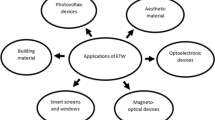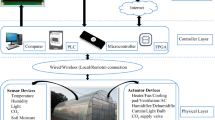Abstract
This paper presents the first results of wood density measurement using a microwave sensor. The information given by the sensor are amplitude variations and phase variations of the transmitted wave. This work concerns the calibration of the sensor. To eliminate the problem of wood anisotropy we used boards made from glued and pressed sawdust. There are 5 kinds of sawdust and from each five different board densities were prepared. The first measurements concerned the geometry and the realibility of the sensor. The results show that the sensor does not present defect geometry and that its readings are reliable. Then we looked for a relationship between board density and the variations of the microwave parameters. An accurate linear relationship was found, but it appears to be necessary to consider each sawdust type separately. Based on these results we prepared other samples with different glue contents to control the influence of glue on microwave parameters. The results show that in our ranges of densities (0.55–0.75 g/cm3) and glue contents (6–12%) the influence of glue is negligible. Furtheron, it appears that measuring the amplitude variation may be a means for controlling the granulometry of particle boards.
Zusammenfassung
Der Artikel beschreibt erste Ergebnisse der Holzdichtemessung mittels eines Mikrowellensensors. Als Informationsträger werden die Veränderungen der Amplitude und der Phase der Wellen nach Transmission genutzt. Die Arbeit betrifft vor allem die Kalibrierung des Sensors. Um Probleme der Holz-Anistropie auszuschalten, wurden Platten aus verleimtem Sägemehl hergestellt. Fünf verschiedene Sägemehltypen wurden zu jeweils fünf Platten unterschiedlicher Dichte verpreßt. Die ersten Messungen betreffen die geometrischen Faktoren und die Zuverlässigkeit des Sensors. Der Sensor erwies sich als frei von geometrischen Abweichungen und liefert verläßliche Meßwerte. Danach wurden die Beziehungen zwischen Plattendichte und Veränderungen der Mikrowellen-Parameter untersucht. Es ergab sich mit guter Näherung eine lineare Beziehung, wobei jedoch die unterschiedliche Herkunft des Sägemehls gesondert berücksichtigt werden muß. Weitere Platten wurden vermessen, um den Einfluß des Leimgehaltes zu ermitteln. Im untersuchten Bereich der Plattendichte (0.55–0.75 g/cm3) erwies sich der Einfluß des Leimgehaltes (6 bis 12%) als vernachlässigbar. Es ergaben sich zudem Hinweise darauf, daß die Amplitudenänderung zur Kontrolle der Partikelgröße in Platten herangezogen werden kann.
Similar content being viewed by others
Literature
Boevskaya, I. A.; Portnik, Z. H.; Merem'Yanin, Y.: The influence of wood moisture content and density on its dielectric properties. Lesnoi Zhurnal 1 (1986) 123–125
James, W. L.; Yen, Y. H., King, R. J.: A microwave method for measuring moisture content, density and grain orientation. U.S.D.A. Forest Prod. Lab. Research Note FPL-025 1985
King, R. J.: Microwave electromagnetic nondestructive testing of wood. 4th Nondestructive Testing of Wood Symposium 1978
Lambert, P.: Etude et réalisation de capteurs micro-ondes industriels pour la valorisation du bois. Thèse de l'université de Nancy J 1990
Makoviny, I.: Zur Anisotropie der Dielektrizitätskonstanten des Holzes in grundlegenden anatomischen Richtungen. Holztechnologie 29 (4) (1988) 210–213
Maloigne, C., Croche, R.: Classification des défauts observe dans le bois par caméra. Traitement du signal 5 (1988) 41–48
Martin, P.: La productique et les industries du bois. Ed. hermès 1989
Peykens, M.; de Poureq, M.; Stevens, M.; Schalck, J.: Dielectric properties of softwood species at microwave frequencies. Wood Sci. Technol. 18 (1984) 267–280
Polge, H.: Etablissement des courbes de variations de la densité du bois par exploration densitométrique de radiographies d'échantillons prélevés à la tarière sur les arbres vivants. Application dans les domaines technologique et physiolique. Thèse de doctorat d'état, Nancy 1966
Samson, M.: Transverse scanning for automatic detection of general slope of grain in lumber. Forest. Prod. J. 38 (7/8) (1988) 33–38
Tinga, W. R.; Voss, W. A. G.; Blossey, F. F.: Generalized approach to multiphase dielectric mixture theory. J. Appl. Phys. 44 (9) (1973) 3897–3902
Author information
Authors and Affiliations
Rights and permissions
About this article
Cite this article
Goy, B., Martin, P. & Leban, J.M. The measurement of wood density by microwave sensor. Holz als Roh-und Werkstoff 50, 163–166 (1992). https://doi.org/10.1007/BF02663259
Issue Date:
DOI: https://doi.org/10.1007/BF02663259




